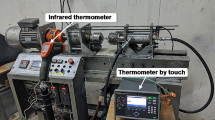Conclusions
-
1.
Two concentrations of tungsten are characteristic for high-speed steel containing no more than 1.7–1.9% V and possessing good grindability.
-
a)
at 7–8% W — high red hardness and secondary hardness values and a lower carbide inhomogeneity are assured; but sensitivity to overheating is preserved;
-
b)
at 12–13% W — the fine grain is maintained, but the steel displays a somewhat higher carbide inhomogeneity than the steel with 7–8% W.
-
2.
The sensitivity of 7–8% W steel to overheating may be reduced by addition of 0.1–0.2% Ti, or 0.01–0.02%N, or 0.7–1% Ni. The above additions increase the strength and diminish the amount of residual austenite.
-
3.
In order to reduce carbide inhomogeneity it is possible to decrease the contents of chromium in steel to 2.8–3%. This causes the strength to increase and the quantity of residual austenite to diminish. A drop in chromium contents to below 2.2–2.5% prevents the dissolution of complex tungsten carbides and reduces considerably the secondary hardness.
-
4.
For tools with a thin cutting edge (tape, reamers, broaches, and so on) it is recommended to use steel R12 containing 0.8–9% C, 12–13% W, 2.8–3% Cr, 1.5–1.9% V, and 0.3–0.6% Ni (quenching from 1235–1255°C in oil or in hot media and triple tempering at 560–570°C).
-
5.
For instruments designed for machining of hard (up to HB 200) materials under moderate cutting conditions, and which must have a low carbide inhomogeneity, it is recommended to use steel R7T (0.75–0.83% C, 7.6–8.2% W, 2.7–3.2% Cr, 1.2–1.5%V, 0.1–0.2% Ti, 0.4–0.8% Ni), or steel R7 into which nitrogen should be introduced instead of titanium (quenching from 1200–1220°C in oil or in hot media, tempering at 540–550°C, three times 1 hour each).
Similar content being viewed by others
References
Yu.A. Geller, Meshcherinova. O.N. and Tikhomirova, Ye.K. Steel, No. 9, 1951.
Ye.I. Malinkina. Steel, No. 12, (year omitted in original journal).
N.A. Minkevich, and Ivanov, O.S. Transactions of the Institute of Steel, No. 13, 1939.
A.P. Gulyayev. Low-alloyed tungsten and molybdenum high-speed steels, Mashgiz, 1941.
M.V. Pridantsev, and Ostapchuk, A. Steel, No. 8–9, 8–9, 1938.
E. Houdermont, and Schrader, H. Techn. Mit. Krupp., Vol. 5, 1937.
A.P. Gulyayev. Steel, No. 3, 1946.
F. Kaiser, and Cohen, M. Metal Progress, No. 6, 1952.
N.T. Chebotarev. Bulletin of the Soviet Academy of Sciences, Physical Series, Vol. 12, No. 1, 1951.
Yu.A. Geller, Onishchik, Ye.I., and Mel'nichenko, Ye.V. Symposium “Metallography and Heat Treatment Processes”, supplement to the magazine Steel, 1958.
Yu.A. Geller. Bulletin of the Soviet Academy of Sciences, Division of Technical Sciences, No. 5. 1954.
M.D. Perkas. Symposium “Problems of Metallography and Physical Metallurgy”, Metallurgizdat, 1952.
P.M. Yushkevich. Physical Metallurgy and Metallography, No. 11, 1959.
M.L. Korolove. Nitrogen as an Alloying Element of steel, Metallurgizdat, 1960.
Ye.P. Starova. The Low-Alloy High-Speed Steels with Nitrogen, Masgiz, 1953.
Author information
Authors and Affiliations
Rights and permissions
About this article
Cite this article
Geller, Y.A., Kremnev, L.S. & Olesova, T.L. High-speed steels with low carbide inhomogeneity. Met Sci Heat Treat 3, 257–263 (1961). https://doi.org/10.1007/BF00813003
Issue Date:
DOI: https://doi.org/10.1007/BF00813003




